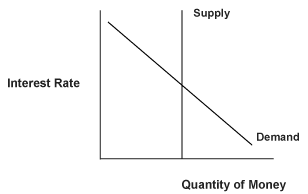CFA Level 1 - Macroeconomics
I. The Supply and Demand of Money
People hold money:
Holding money has an opportunity cost in the sense that the money could be invested elsewhere and earn interest. Even if the money is held in an interest-earning checking account, a higher rate of interest could be earned by purchasing financial instruments such as bonds.
As the rate of interest goes higher, the opportunity cost of money increases. So as interest rates go up (down), people will be less (more) willing to hold money.
The supply of money is usually determined by the Central Bank (Canada ) or the Federal Reserve (U.S.
A graph for the supply and demand for money, as a function of the interest rate, would appear similar to figure 4.4 on the following page.
Figure 4.4: The Supply and Demand for Money
Note that this demand curve assumes other relevant factors are held constant. If the quantity of goods produced increases and/or the price level increases, the demand for money will increase. This causes the demand curve to shift to the right. If economic activity declines and/or prices go down, then demand for money will decrease.
Changes in the availability of financial instruments are also changing the demand for money over time. The widespread availability of credit cards has reduced the amount of money that households need to keep on hand.
Determining Interest RatesInterest rates are determined by the interaction of the quantity supplied and the quantity demanded of money. The quantity supplied of money is determined by the actions of the central bank and the banking system. Suppose that the interest rate is too high in the sense that the quantity of money supplied is greater than the quantity of money demanded. People will respond by purchasing bonds, in which case money will be reduced. The greater demand for bonds will push interest rates down, towards equilibrium.
Short and Long-run Effects of Money on Real GDP·Short-Run, Anticipated - If individuals correctly anticipate inflation, in the short-run an expansionary (restrictive) monetary policy will increase (decrease) prices. Real output and employment will remain the same. Nominal interest rates will increase while real interest rates will stay the same.
·Long-Run, Anticipated - Expansionary (restrictive) monetary policy will increase (decrease) the rate of inflation and increase (decrease) nominal interest rates. Real interest rates, employment levels and real output are not affected by monetary policy.
·Short-Run, Unanticipated - Unanticipated expansionary monetary policy, assuming the economy is not at full employment, will somewhat increase prices, increase real output and reduce real interest rates. Unanticipated restrictive monetary policy will increase real interest rates, decrease the inflation rate, reduce employment and reduce output. This type of policy is appropriate when the economy is operating at greater than full employment.
·Long-Run, Unanticipated - Expansionary monetary policy will lead to higher inflation and nominal interest rates while real interest rates, real output and real employment will not be positively impacted. An important point to remember is that, in the long run, inflation is the primary effect of expansionary monetary policy.
People hold money:
- To conduct transactions
- For precautionary reasons, such as to meet emergencies, such as unexpected medical bills
- As a store of value
Holding money has an opportunity cost in the sense that the money could be invested elsewhere and earn interest. Even if the money is held in an interest-earning checking account, a higher rate of interest could be earned by purchasing financial instruments such as bonds.
As the rate of interest goes higher, the opportunity cost of money increases. So as interest rates go up (down), people will be less (more) willing to hold money.
The supply of money is usually determined by the Central Bank (
A graph for the supply and demand for money, as a function of the interest rate, would appear similar to figure 4.4 on the following page.
Figure 4.4: The Supply and Demand for Money
 |
Changes in the availability of financial instruments are also changing the demand for money over time. The widespread availability of credit cards has reduced the amount of money that households need to keep on hand.
Determining Interest RatesInterest rates are determined by the interaction of the quantity supplied and the quantity demanded of money. The quantity supplied of money is determined by the actions of the central bank and the banking system. Suppose that the interest rate is too high in the sense that the quantity of money supplied is greater than the quantity of money demanded. People will respond by purchasing bonds, in which case money will be reduced. The greater demand for bonds will push interest rates down, towards equilibrium.
Short and Long-run Effects of Money on Real GDP·Short-Run, Anticipated - If individuals correctly anticipate inflation, in the short-run an expansionary (restrictive) monetary policy will increase (decrease) prices. Real output and employment will remain the same. Nominal interest rates will increase while real interest rates will stay the same.
·Long-Run, Anticipated - Expansionary (restrictive) monetary policy will increase (decrease) the rate of inflation and increase (decrease) nominal interest rates. Real interest rates, employment levels and real output are not affected by monetary policy.
·Short-Run, Unanticipated - Unanticipated expansionary monetary policy, assuming the economy is not at full employment, will somewhat increase prices, increase real output and reduce real interest rates. Unanticipated restrictive monetary policy will increase real interest rates, decrease the inflation rate, reduce employment and reduce output. This type of policy is appropriate when the economy is operating at greater than full employment.
·Long-Run, Unanticipated - Expansionary monetary policy will lead to higher inflation and nominal interest rates while real interest rates, real output and real employment will not be positively impacted. An important point to remember is that, in the long run, inflation is the primary effect of expansionary monetary policy.






0 comments:
Post a Comment